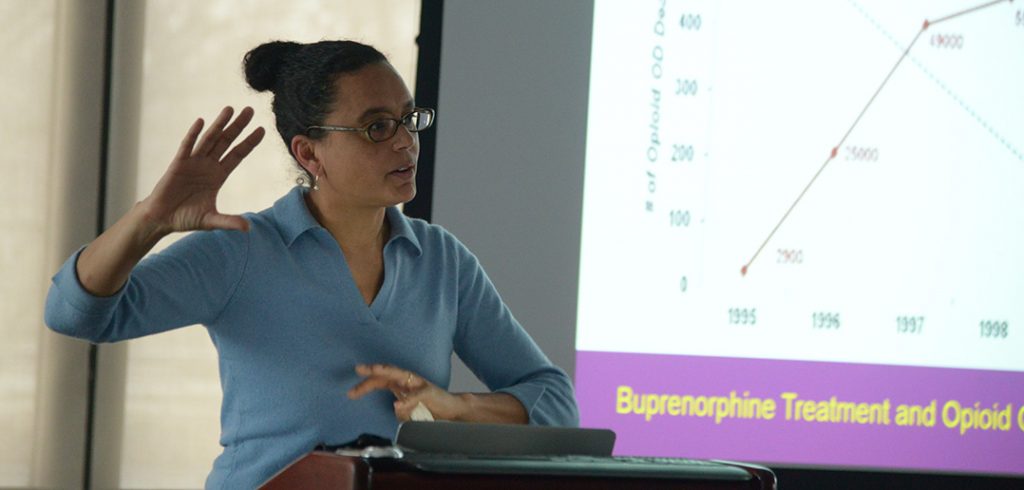To fully grasp how opioid addiction has affected United States communities, Americans need to see race as a key factor in how we approach drug addiction.
That was the conclusion of Helena B. Hansen, M.D., Ph.D., assistant professor of psychiatry and anthropology at New York University, in a March 8 lecture, “White Opioids: Pharmaceuticals, Race, and the War on Drugs That Wasn’t,” at the Rose Hill campus.
Dr. Hansen, whose visit was sponsored by the Center for Ethics Education, argued that the current crisis is partly the result of a stark racial divide: When white Americans become addicted, it’s seen as proof of a breakdown of society, but when minorities become addicted, it’s viewed as evidence of an individual’s moral failing.
This outlook was reflected in the 1980s when penalties for possession of crack were higher than for possession of cocaine, she said. It has continued with the creation, marketing, and distribution of buprenorphine, which is commonly sold under the name Suboxone, a pain killer geared specifically to white, middle class Americans. Dr. Hansen compared it (and its predecessor, Oxycodone) to Methadone, which is distributed in troubled inner-city neighborhoods.
“The current generation of opioids were designed to have white racial identities, and in our stratified health care and justice systems, the biotechnologies and social technologies shaping opioid consumption reinforce racial inequalities, while at the same time harming whites,” she said.
Suboxone has never been explicitly promoted as a white person’s drug, but Dr. Hansen described four “technologies of whiteness”-addiction neuroscience, new biotechnologies, regulatory structures, and marketing-that showed how it was inexorably linked to race.
When it comes to regulatory structures, for instance, she recounted that Congress passed the Drug Addiction Treatment Act (DATA) in 2000, thus enabling physicians to prescribe Suboxone in their offices. The debates leading up to passage focused on a “new kind of drug user,” one that is young, suburban and “not hardcore”: implicitly, white.
“Alan Leshner, then director of the National Institute on Drug Abuse, testified that [Suboxone] is uniquely appropriate for a new kind of opioid user, as opposed to Methadone- ‘which tends to be concentrated in urban areas, and is a poor fit for the suburban spread of narcotic addiction,'” she said.
The solution to keeping [Suboxone] out of illicit markets-an eight-hour certification course that doctors are required to take in order to prescribe it-has further made it scarce for minorities.
“Public-sector doctors tell me that the certification requirement is a major barrier to making [Suboxone] available to low income people, as public clinics do not provide time or incentives to pursue certification,” she said, “while prescribers in the private sector can charge fees of up to $1,000 for an initial visit for [Suboxone] induction,” she said.
This sort of racial targeting has actually hurt whites as much as it has hurt minorities, she said. It has led to implicit assumptions that whites are not as susceptible to addiction-even as Oxycontin addiction rates among whites have climbed, due to a ten-fold increase in prescription opioids nationally, “with the disproportionate uptake by prescribers in white suburban and rural areas.”
In the long run, Dr. Hansen expressed hope that this current moment of despair over white deaths will spur efforts to transform America’s health care system into one that’s less market driven and more equitable.
“Our predominant frame for addiction in this country has-until recently-been that it’s an individual, moral character problem . . . [that]people are making bad choices, they’re just not strong enough, or perhaps they come from bad families with bad values,” she said.
“Americans are beginning to realize that maybe addiction is related to our economic system and the social networks that people don’t now have.”


